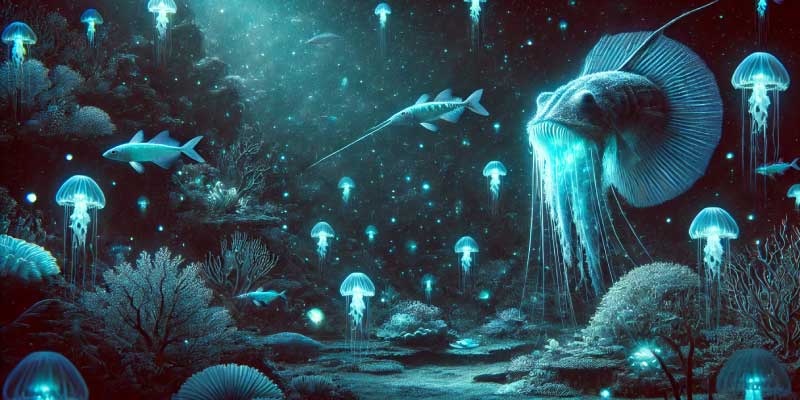The deep sea is one of our planet’s most mysterious and least explored regions. It covers more than 60% of Earth’s surface and is crucial in regulating the planet’s climate, supporting marine biodiversity, and even influencing human life. Despite its significance, the deep sea remains largely unexplored due to its extreme conditions, such as complete darkness, crushing pressure, and freezing temperatures.
This article will dive into the depths of the deep sea, exploring its characteristics, life forms, and why it is essential for the Earth’s health.
What is the Deep Sea?
The deep sea refers to the part of the ocean that lies below 200 meters (656 feet), beyond the reach of sunlight. It is divided into several depth zones:
The Mesopelagic Zone (200–1000 meters) – Twilight Zone
- Faint sunlight penetrates but is too weak for photosynthesis.
- Home to bioluminescent (glowing) creatures like lanternfish and squid.
The Bathypelagic Zone (1000–4000 meters) – Midnight Zone
- No sunlight at all, complete darkness.
- High water pressure and near-freezing temperatures.
- Strange creatures like anglerfish, giant squid, and gulper eels inhabit this zone.
The Abyssopelagic Zone (4000–6000 meters) – The Abyss
- Pitch black, icy cold, and high pressure.
- Home to deep-sea cucumbers, dumbo octopuses, and giant amphipods.
The Hadal Zone (6000+ meters) – The Deep Trenches
- Found in deep ocean trenches like the Mariana Trench (10,994 meters deep).
- The harshest environment on Earth, yet life still exists, including snailfish and giant isopods.
Why is the Deep Sea Important for Earth?
The deep sea is vital to Earth’s health. Here’s why:
Regulates Climate and Stores Carbon
- The deep sea absorbs and stores carbon dioxide, helping to reduce global warming.
- The ocean’s thermohaline circulation (deep ocean currents) transports heat around the globe, influencing climate patterns.
Supports Marine Biodiversity
- The deep sea hosts millions of undiscovered species, making it one of the most diverse ecosystems on Earth.
- Unique adaptations, like bioluminescence, help species survive in complete darkness.
Produces Oxygen
- Deep-sea plankton contribute to oxygen production, supporting marine life and humans.
- The ocean absorbs CO2, reducing greenhouse gas levels in the atmosphere.
Provides Food and Medicine
- Deep-sea fisheries supply seafood, though overfishing threatens sustainability.
- Unique organisms contain compounds used in medicines, including antibiotics and cancer treatments.
Supports Earth’s Geological Processes
- Hydrothermal vents release minerals that support life and influence Earth’s chemical cycles.
- The deep sea plays a role in stabilizing tectonic activity and carbon storage.
Threats to the Deep Sea
Despite its remoteness, the deep sea is at risk due to human activities:
Deep-Sea Mining
- Mining for metals like cobalt and manganese destroys fragile ecosystems.
- Can lead to species extinction before they are even discovered.
Plastic Pollution
- Plastic waste, including microplastics, has been found in the deepest trenches, harming marine life.
- Many deep-sea creatures mistake plastic for food, leading to fatal consequences.
Climate Change & Ocean Warming
- Rising sea temperatures disrupt deep-sea currents, affecting global climate stability.
- Acidification weakens marine organisms’ shells and reduces biodiversity.
Overfishing & Habitat Destruction
- Deep-sea species, like orange roughy and Patagonian toothfish, are overfished due to slow reproduction rates.
- Trawling nets destroy fragile coral and seabed ecosystems.
How Can We Protect the Deep Sea?
Protecting the deep sea is essential for a balanced planet. Some key solutions include:
Strengthening Ocean Protection Laws
- Establish more marine protected areas (MPAs) to prevent industrial exploitation.
- Enforce bans on harmful deep-sea mining practices.
Reducing Plastic Pollution
- Limit single-use plastics and improve global waste management.
- Support clean-up initiatives that remove plastic from the ocean.
Sustainable Fishing Practices
- Implement strict fishing quotas to prevent overfishing.
- Use selective, eco-friendly fishing methods that don’t harm deep-sea habitats.
Raising Awareness and Supporting Research
- Funding deep-sea exploration can help us understand its biodiversity and importance.
- Educating people about deep-sea conservation can drive policy changes and public action.
Final Thoughts
The deep-sea is Earth’s last frontier, a hidden world of incredible creatures and vital ecological functions. It plays a crucial role in climate regulation, biodiversity support, and the planet’s overall health. However, human activities threaten this fragile ecosystem, and urgent action is needed to protect it.
By reducing pollution, promoting sustainable practices, and supporting ocean conservation, we can help preserve the deep sea for future generations.










 Dutch
Dutch English
English French
French German
German Hindi
Hindi Punjabi
Punjabi Swedish
Swedish